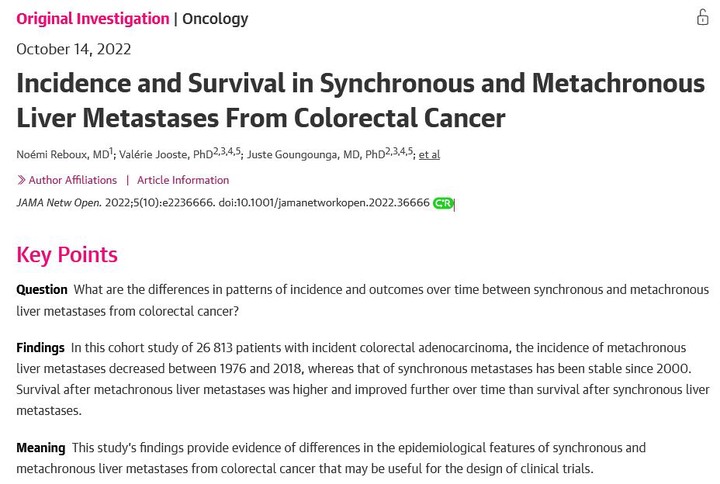Incidence and Survival in Synchronous and Metachronous Liver Metastases From Colorectal Cancer

Abstract
IMPORTANCE: Although treatment and prognosis of synchronous liver metastases from colorectal cancer are relatively well known, a comparative description of the incidence, epidemiological features, and outcomes of synchronous and metachronous liver metastases is lacking. The difference in prognosis between patients with synchronous and metachronous liver metastases is controversial.
OBJECTIVE: To investigate temporal patterns in the incidence and outcomes of synchronous vs metachronous liver metastases from colorectal cancer.
DESIGN, SETTING, AND PARTICIPANTS: This population-based cohort study used information from a French regional digestive cancer registry accounting for 1,082,000 inhabitants. A total of 26,813 patients with a diagnosis of incident colorectal adenocarcinoma diagnosed between January 1, 1976, and December 31, 2018, were included. Data were analyzed from February 7 to May 20, 2022.
MAIN OUTCOMES AND MEASURES: Age-standardized incidence was calculated. Univariate and multivariate net survival analyses were performed.
RESULTS: Of 26,813 patients with colorectal cancer (15,032 men [56.1%]; median [IQR] age, 73 [64-81] years), 4,546 (17.0%) presented with synchronous liver metastases. The incidence rate of synchronous liver metastases was 6.9 per 100,000 inhabitants in men and 3.4 per 100,000 inhabitants in women, with no significant variation since 2000. The 5-year cumulative incidence of metachronous liver metastases decreased from 18.6% (95% CI, 14.9%-22.2%) during the 1976 to 1980 period to 10.0% (95% CI, 8.8%-11.2%) during the 2006 to 2011 period. Cancer stage at diagnosis was the strongest risk factor for liver metastases; compared with patients diagnosed with stage II cancer, patients with stage III cancer had a 2-fold increase in risk (subdistribution hazard ratio, 2.42; 95% CI, 2.08-2.82) for up to 5 years. Net survival at 1 year was 41.8% for synchronous liver metastases and 49.9% for metachronous metastases, and net survival at 5 years was 6.2% for synchronous liver metastases and 13.2% for metachronous metastases. Between the first (1976-1980) and last (2011-2016) periods, the adjusted ratio of death after synchronous and metachronous metastases was divided by 2.5 for patients with synchronous status and 3.7 for patients with metachronous status.
CONCLUSIONS AND RELEVANCE: In this study, the incidence of colorectal cancer with synchronous liver metastases changed little over time, whereas there was a 2-fold decrease in the probability of developing metachronous liver metastases. Survival improved substantially for patients with metachronous liver metastases, whereas improvement was more modest for those with synchronous metastases. The differences observed in the epidemiological features of synchronous and metachronous liver metastases from colorectal cancer may be useful for the design of future clinical trials.